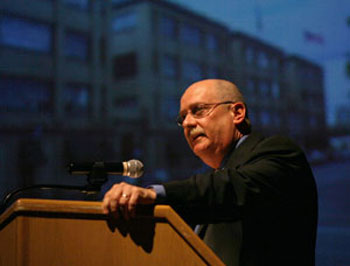 "Abstract painting is about love, birth, death, and all the great ecstatic experiences of being human. It is like those first wild marks we make as a child, which announce to the world, ‘I am here!’"
"Abstract painting is about love, birth, death, and all the great ecstatic experiences of being human. It is like those first wild marks we make as a child, which announce to the world, ‘I am here!’"
The first art professor to deliver a LaFollette Lecture in the Humanities, Professor Greg Huebner H’77 asked his audience to think of his presentation as "the First LaFollette Performance Art."
Part art history, part autobiography, Huebner’s "Life at a Half Bubble Off Plumb: Rethinking Truth, Beauty, and Jumbo Shrimp" also offered a visual walk through the decisions Huebner made creating one of his paintings.
We can’t begin to capture the whole palette of this "lecture" and its 91 images on one page. You’ll find both a summary and the full meal at WM Online, but here’s a morsel:
When one of my students tells me he wishes to major in art, this proclamation is usually followed by the comment, "Do you have any suggestions how I should break the news to my parents?" The student’s expression when asking this question is that of someone who has learned they are terminally ill and are searching for the appropriate means to tell the family the sad news.
The truth of the matter is the artist has absolutely no choice in the matter. You create and make art. It is who you are and what you must do. And it begins at a very young age.
I had always loved to draw as a child and art was the only subject in which I ever received an A during my eight interminable years of grade school. In 1959 I asked my fifth grade teacher, Sister Ramona, if my parents would allow me to bring our portable TV from home, would she let the class watch some of the White Sox and Dodgers in the World Series. In those days the World Series was played during daylight hours. Sister Ramona thought about it for a while and said, "Mr. Huebner, I will let the class watch some of the World Series if you do the art for my bulletin boards for the remainder of the year." The remainder of the year? It was only the beginning of October.
It was tough growing up in Chicago. Everybody had an agenda, even the nuns. But the thought of missing my White Sox in the first two games of the series was too much to bear so I sold my soul to Sister Ramona.
The Catholic Church has a long history of patronage for the arts, and Sister Ramona was my first patron. I was her Michelangelo and she was my Pope Julius II. And, just as Michelangelo and Julius had an occasional difference of opinion, Sister Ramona and I had our moments. I remember a particular occasion when my pleas for artistic license fell on deaf ears. It was getting close to Easter and Sister Ramona wanted an image appropriate for such an important season in the Catholic Church. I thought it would be great if I drew Christ driving a 1957 Chevy convertible up to heaven and waving to everyone. It looked great and I was so proud of the job I did on the 57 Chevy, but it was met with stern rejection from Sister Ramona. "Tradition, Mr. Huebner, tradition. We can’t have our Savior flying around the heavens in a Chevy." It was my first encounter with a negative critic, but like we were so often told by the good Sisters, "Our suffering here on earth was temporary." Sister Ramona kept the drawing, she said, "So no one will see such an image of Christ." As she said this to me it looked like she was trying very hard not to smile.
I always felt that if I could ever get into the convent next to our school I would find my "Ascending Christ in Chevy" on the wall of Sister Ramona’s room.